Table of Contents
Introduction
Spirulina Statistics: Spirulina, classified as a type of blue-green algae, is well-known for its dense nutritional content and perceived health benefits. It contains abundant protein, vitamins, minerals, antioxidants, and essential fatty acids.
Many individuals use Spirulina as a supplement to support the immune system and potentially alleviate inflammation and oxidative stress. Additionally, it’s believed to reduce LDL cholesterol levels and boost energy levels potentially.
Due to its versatility, Spirulina is frequently employed as a natural food coloring or dietary supplement in various food products. Its rapid growth rate and minimal environmental impact make it an environmentally friendly food source with possible ecological advantages.
In summary, Spirulina offers a practical and nutrient-rich option for enhancing overall health and well-being.
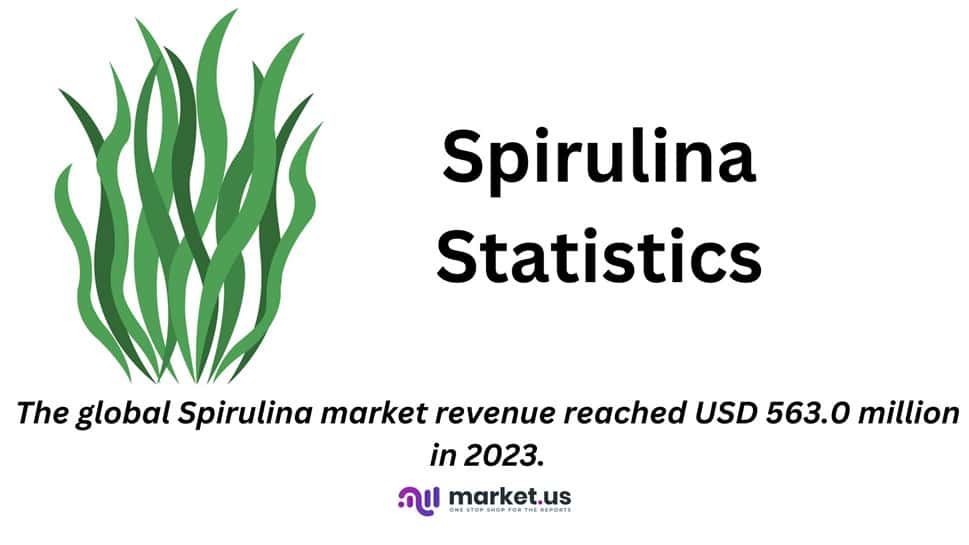
Editor’s Choice
- By 2032, the global Spirulina market revenue is forecasted to reach USD 1,338.4 million.
- Spirulina is renowned for its high protein content, comprising approximately 60-70% of its composition, making it an excellent source of plant-based protein.
- Earthrise Nutritionals in the USA produces Spirulina Natural primarily for food consumption, available in powder and capsule forms. With an annual production of 550 tons over 5 hectares and marketed at a price range of USD 100-244 per kilogram.
- Spirulina powder, a sought-after superfood renowned for its nutritional benefits, sees significant global export activity. India is the leading exporter, shipping out 2074 kg units.
- The United States emerges as the leading importer, receiving 1970 kg unit shipments. Highlighting the nation’s substantial appetite for this health supplement.
- Investing in nutrients is the second significant factor affecting Spirulina biomass production, constituting around 15% to 25% of overall expenses.
- In 2021, a substantial % of respondents, 25%, preferred products free from artificial ingredients. Reflecting a heightened awareness and demand for natural alternatives.
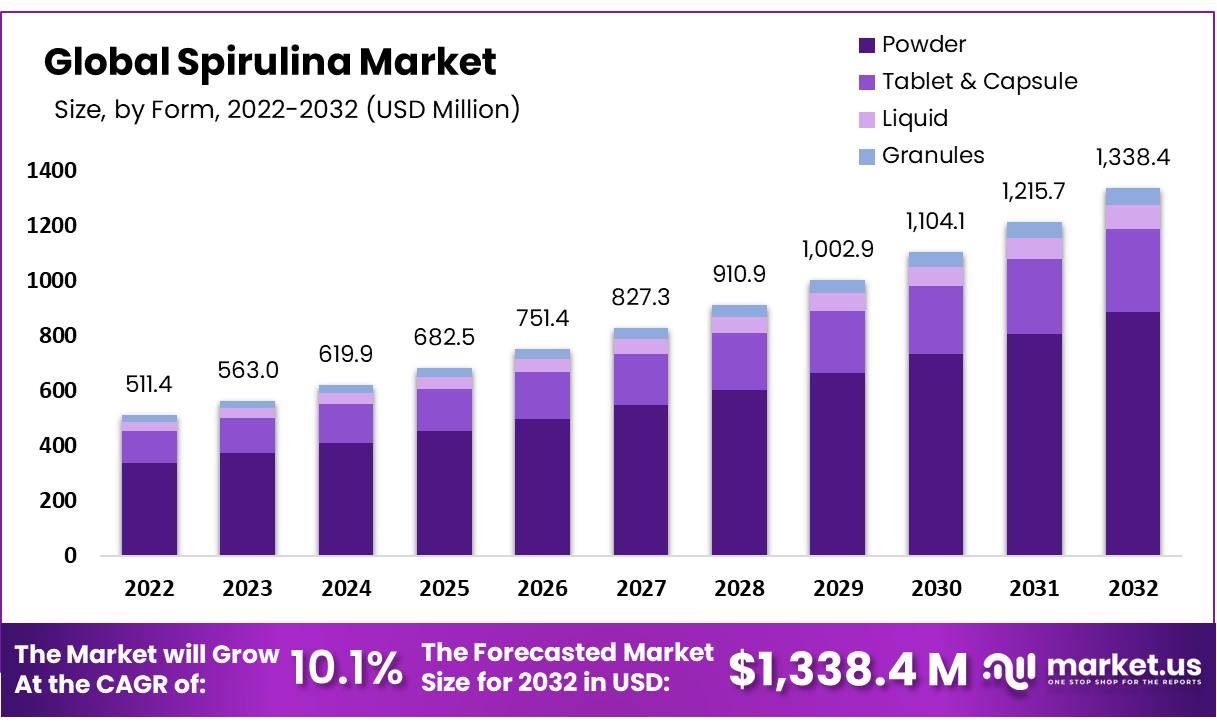
Global Spirulina Market Overview
Global Spirulina Market Size Statistics
- The global Spirulina market has experienced steady growth in revenue over the years at a CAGR of 10.1%, with revenues reaching USD 511.4 million in 2022 and increasing to USD 563.0 million in 2023.
- This growth trend continues, with projections indicating a revenue of USD 619.9 million in 2024 and further increases to USD 682.5 million in 2025, USD 751.4 million in 2026, and USD 827.3 million in 2027.
- The market is expected to surpass the USD 1 billion mark by 2029, reaching USD 1,002.9 million, and continue to rise to USD 1,104.1 million in 2030 and USD 1,215.7 million in 2031.
- By 2032, the global Spirulina market revenue is forecasted to reach USD 1,338.4 million.
- This consistent upward trajectory reflects the growing demand for Spirulina products worldwide, driven by increasing awareness of its nutritional benefits and expanding applications across various industries.
(Source: Market.us)
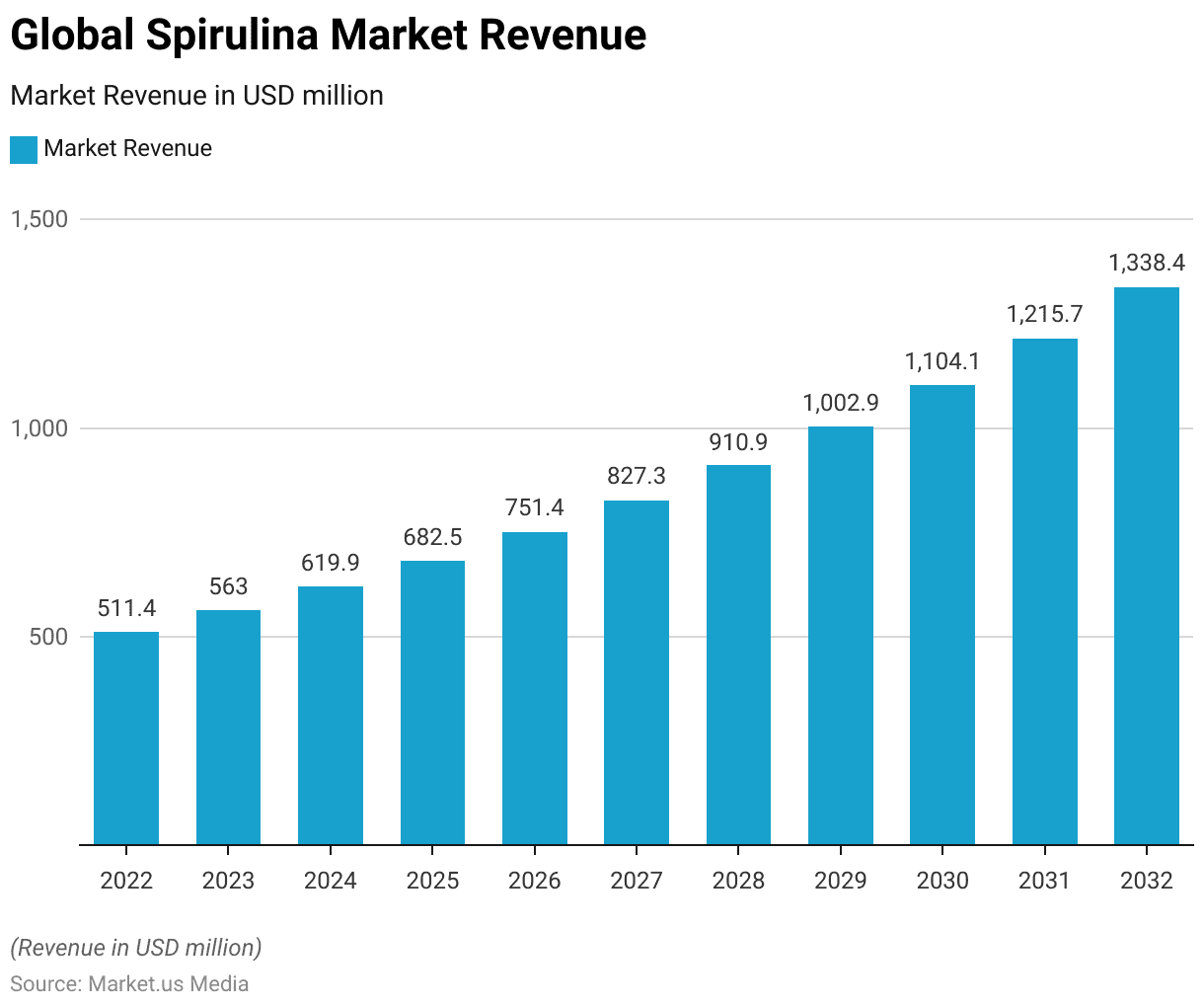
Nutrient Profile of Spirulina Statistics
- Spirulina, per 100 grams, offers a rich nutrient profile. It contains approximately 57 grams of protein, constituting 50-70% of its weight and providing all essential amino acids, making it a complete protein source.
- Additionally, it provides omega-3 fatty acids, including linolenic acid, at a rate of 0.8 grams per 100 grams, and omega-6 fatty acids, such as linoleic acid and GLA, at 1.2 grams per 100 grams.
- While Spirulina contains vitamin B12, it’s essential to note that the form present is a pseudovitamin B12, which is inactive and unreliable for human B12 supplementation.
- Spirulina offers notable amounts of other vitamins, including 11% DV of vitamin A, 17% of vitamin C, 32% of vitamin K, and 25% of vitamin E.
- It’s also a source of various B vitamins like thiamin (B1), riboflavin (B2), niacin (B3), folic acid, and pantothenic acid (B5), along with carotenoids such as beta-carotene, lutein, zeaxanthin, and cryptoxanthin.
- Furthermore, Spirulina contains chlorophyll and provides significant minerals, with notable amounts including 305% DV of copper, 12% DV of calcium, 158% DV of iron, 49% DV of magnesium, 39% DV of potassium, 95% DV of manganese, 13% DV of zinc, and 10% DV of selenium.
- Spirulina offers a comprehensive array of nutrients, making it a valuable addition to a balanced diet.
(Source: Nutrition Stripped)

Key Contents in Spirulina Statistics
- Spirulina, a highly valued dietary supplement, boasts an impressive nutrient profile.
- It is renowned for its high protein content, comprising approximately 60-70% of its composition, making it an excellent source of plant-based protein.
- Additionally, spirulina contains essential lipids, constituting around 4-7% of its content, providing beneficial fatty acids crucial for overall health.
- Carbohydrates are also present in spirulina, albeit in a smaller proportion, accounting for approximately 13.50% of its composition.
- This combination of macronutrients makes spirulina a versatile and nutrient-dense addition to various diets, catering to individuals seeking plant-based protein sources and essential nutrients.
(Source: NCBI)
Production and Cultivation Aspects of Spirulina Statistics
- To ensure successful commercial production of Spirulina, carefully controlling the culture medium’s composition is crucial.
- This involves managing high salts like carbonate and bicarbonate and maintaining an alkaline pH of 9.5 to 9.8. These conditions are necessary to prevent contamination from other microalgae effectively.
- Investing in nutrients is the second significant factor affecting Spirulina biomass production, constituting around 15% to 25% of overall expenses.
- While research on reusing the culture medium for commercial Spirulina production is limited, doing so could result in significant cost savings by reducing water and nutrient consumption. This approach can decrease water demand post-biomass harvesting by up to 84%.
- Temperature significantly impacts Spirulina’s growth rate, with the ideal range between 30°C and 38°C. Growth is inhibited below 17°C and above 38°C, with minimal growth below 15°C.
- Both temperature and geographical location influence Spirulina’s productivity, and no specific temperature zones exist to make cultivation and production more cost-effective.
- Sufficient light is crucial for mass cultivating Spirulina. Providing 30% full sunlight is typically recommended to ensure optimal penetration into the liquid and prevent culture overheating.
(Source: Science Direct)
Application, Commercialized Form, And Marketing Price of Spirulina Biomass Produced Globally
- Globally, Spirulina biomass finds various applications and is commercialized in different forms.
- Earthrise Nutritionals in the USA produces Spirulina Natural primarily for food consumption, available in powder and capsule forms, with an annual production of 550 tons over 5 hectares and marketed at a price range of USD 100-244 per kilogram.
- Cyanotech Co. in the USA offers Hawaiian Spirulina as a food product in powder and tablet forms, produced over 36.5 hectares, with a sales value ranging from USD 105 to USD 190 per kilogram.
- In Japan, DIC Lifetec Co. produces DIC Spirulina in powder and tablet forms for food and feed purposes, with an annual production of 350 tons.
- Parry Nutraceuticals in India produces Organic Spirulina in powder and tablet forms over 53 hectares. Fazenda Tamanduá and Brasil Vital in Brazil offer Spirulina in various forms, including nibs, powder, and capsules, with sales values ranging from USD 70 to USD 280 per kilogram.
- Olson Nutrição in Brazil produces Spirulina in nibs, powder, and capsule forms, with a production of 0.4 tons over 0.04 hectares.
- In China, CHINA C.B.N and F. K. Dnarmsa Spirulina produce Spirulina biomass for food and feed applications in powder and tablet forms, with annual productions of 1200 and 1600 tons, respectively.
- Additionally, Spirulina biomass is produced for food consumption in Chile by Spirulina Mater©, available in powder, tablet, and capsule forms, with sales values ranging from USD 40-270 per kilogram.
(Source: Science Direct)
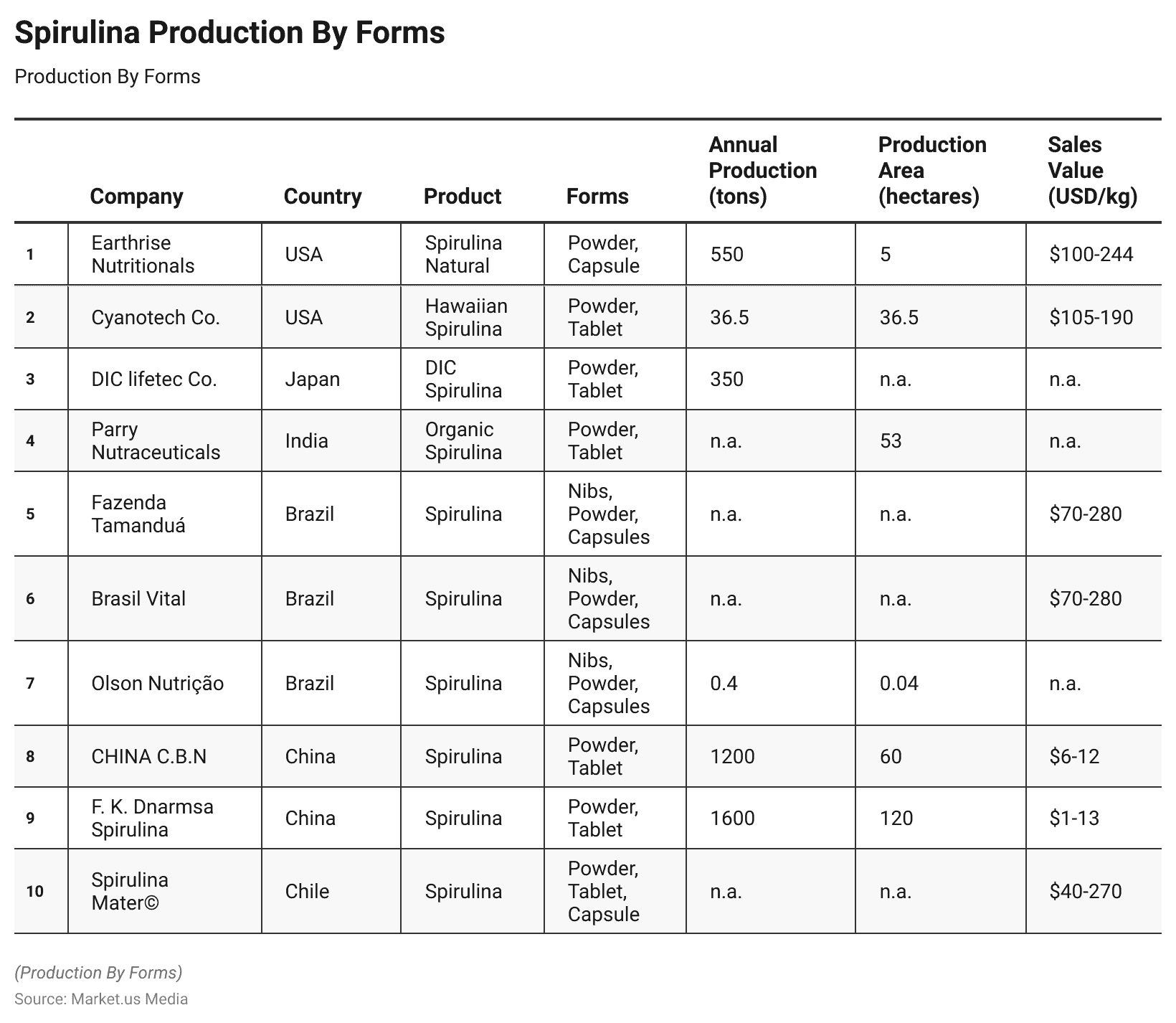
Top Exporters of Spirulina Powder Statistics
- Spirulina powder, a sought-after superfood renowned for its nutritional benefits, sees significant global export activity, with India as the leading exporter, shipping out 2074 kg units.
- Following closely behind, China occupies a substantial market share with 1838 kg unit shipments.
- South Korea, the United States, and Hong Kong also contribute prominently to global trade, with 257, 189, and 107 kg unit shipments, respectively.
- Other notable exporters include Malaysia with 72 shipments, Singapore with 48, and Sri Lanka with 42 kg unit shipments.
- Additionally, Indonesia and Vietnam exhibit modest export volumes, with 38 and 32 kg unit shipments, respectively.
- This distribution underscores the widespread demand and commercial viability of Spirulina powder across diverse markets, reflecting its growing popularity as a health supplement on a global scale.
(Source: Volza)

Top Importers of Spirulina Powder
- Spirulina powder enjoys robust demand worldwide, evidenced by the significant import activity across various countries.
- The United States emerges as the leading importer, receiving 1970 kg unit shipments. Highlighting the nation’s substantial appetite for this health supplement.
- Vietnam and France follow closely behind, importing 210 and 202 kg units, respectively. Indicating a growing interest in Spirulina’s nutritional properties.
- Bangladesh and India each receive 168 kg unit shipments, showcasing a considerable market presence in South Asia.
- The Netherlands, South Korea, Germany, and the Philippines also demonstrate notable import volumes, with 152, 138, 130, and 130 kg unit shipments respectively.
- Additionally, Indonesia contributes to the global import market with 105 kg unit shipments.
- This diverse distribution underscores the widespread recognition of the health benefits of Spirulina powder and its integration into various global markets, reflecting its status as a popular dietary supplement worldwide.
(Source: Volza)
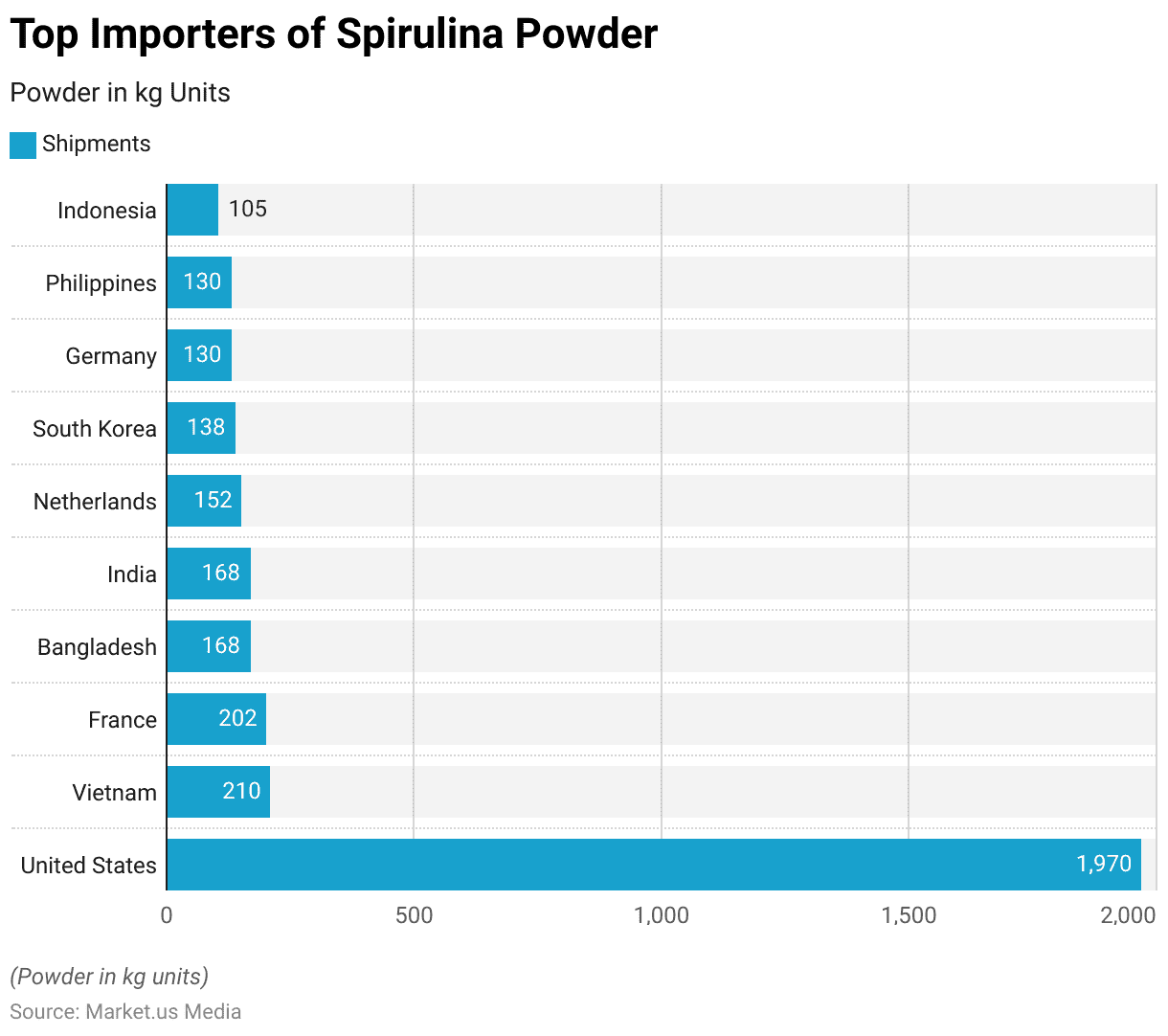
Consumer Preferences
- In 2021, consumer preferences regarding Spirulina Extract showcased a notable inclination towards clean-label products, as evidenced by the percentages attributed to various factors.
- Notably, a substantial portion of respondents, 25%, preferred products free from artificial ingredients. Reflecting a heightened awareness and demand for natural alternatives.
- Similarly, 23% favored products with a natural/organic claim, indicating a propensity towards authenticity and transparency in labeling.
- Moreover, 20% of respondents emphasized the importance of products free from chemicals. Highlighting a growing concern for the purity and safety of ingredients used.
- Additionally, allergen-free products garnered significant attention, with 13% of respondents expressing a preference for such offerings. Reflecting the importance of catering to diverse dietary needs and sensitivities.
- Furthermore, 12% of respondents prioritized non-GMO products, underscoring a desire for products aligned with sustainable and ethical practices.
- These insights illuminate the evolving landscape of consumer preferences, emphasizing the increasing significance of clean label attributes in shaping purchasing decisions for Spirulina Extract and related products.
(Source: Canada Ltd. Global Survey)
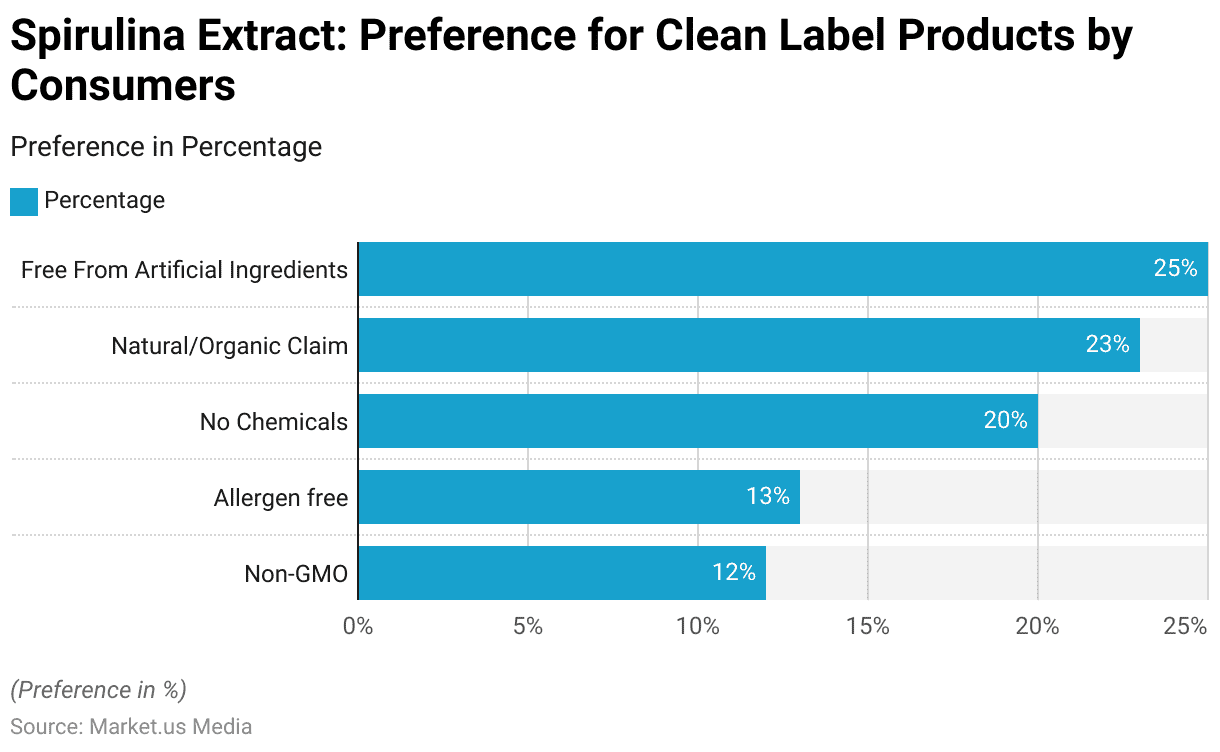
Recent Developments
Increased Investment in Spirulina Production:
Funding initiatives have been observed to support the expansion of spirulina cultivation facilities globally. This includes investments in infrastructure, technology, and research to enhance production efficiency and quality standards.
Growing Demand for Spirulina Supplements:
Market analysis suggests a steady increase in the demand for spirulina-based dietary supplements. Driven by consumer interest in natural health products and awareness of spirulina’s nutritional benefits.
Expansion of Spirulina Product Lines:
Leading companies in the health and wellness sector have diversified their product portfolios to include a wider range of spirulina-based offerings. This includes supplements, functional foods, beverages, and cosmetics, catering to various consumer preferences and lifestyles.
Strategic Partnerships and Collaborations:
Collaborations between spirulina producers, research institutions, and food companies have been observed to drive innovation and market expansion. These partnerships aim to develop new formulations, enhance product quality, and explore novel applications of spirulina in different industries.
Regulatory Developments:
Regulatory agencies worldwide have been reviewing and updating guidelines related to spirulina cultivation, processing, and labeling to ensure consumer safety and product quality. Compliance with these regulations is essential for market players to maintain consumer trust and market access.
Emerging Trends in Spirulina Processing:
Advancements in processing technologies have enabled the development of new spirulina-based products with improved taste, texture, and nutritional profiles. Innovations such as microencapsulation and extrusion techniques are being explored to enhance the functional properties of spirulina in various applications.
Market Consolidation and Acquisitions:
While specific details may vary, there have been instances of mergers and acquisitions within the spirulina industry. Aimed at strengthening market positions, expanding distribution networks, and leveraging synergies to drive growth.
Conclusion
Spirulina Statistics – In brief, Spirulina is a valuable natural asset with significant potential health benefits. Its nutrient-dense profile, encompassing high protein levels, essential fatty acids, vitamins, and minerals, renders it a versatile dietary supplement.
Sustainable farming methods and minimal environmental impact enhance its attractiveness as a food source.
Despite obstacles such as temperature sensitivity and contamination risks, ongoing research, and technological progress continually improve Spirulina production.
Spirulina’s popularity is anticipated to soar as demand grows for clean-label items. Spirulina is a promising solution for global nutritional requirements and health promotion.
FAQs
Spirulina is a blue-green algae that grows in freshwater lakes, ponds, and rivers. It is known for its dense nutritional content and has been consumed for centuries due to its potential health benefits.
Spirulina is rich in protein, vitamins (such as B, A, C, and E), minerals (including iron, calcium, magnesium, and potassium), essential fatty acids, and antioxidants.
Spirulina is believed to have various health benefits, including boosting the immune system, improving energy levels, supporting heart health, aiding in weight management, and providing antioxidant protection against oxidative stress.
Spirulina is commonly consumed as a dietary supplement through tablets, capsules, or powder. It can also be added to smoothies, juices, or water for easy consumption.
Spirulina is generally considered safe for most people when consumed in recommended amounts. However, individuals with certain medical conditions or allergies should consult a healthcare professional before taking Spirulina supplements.
Discuss your needs with our analyst
Please share your requirements with more details so our analyst can check if they can solve your problem(s)



